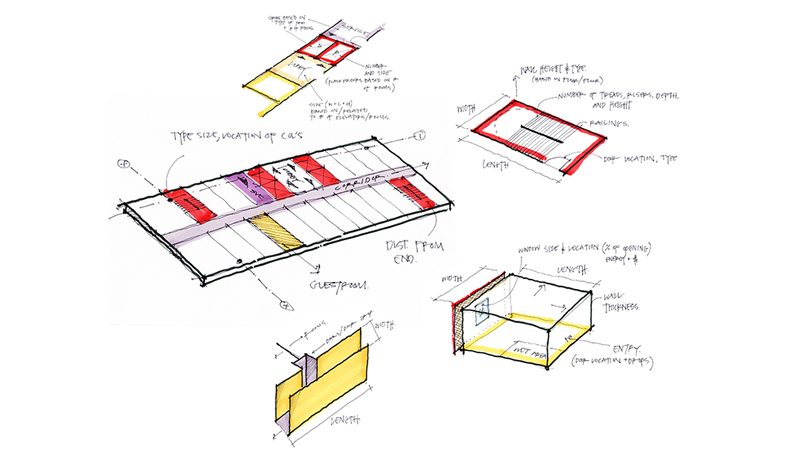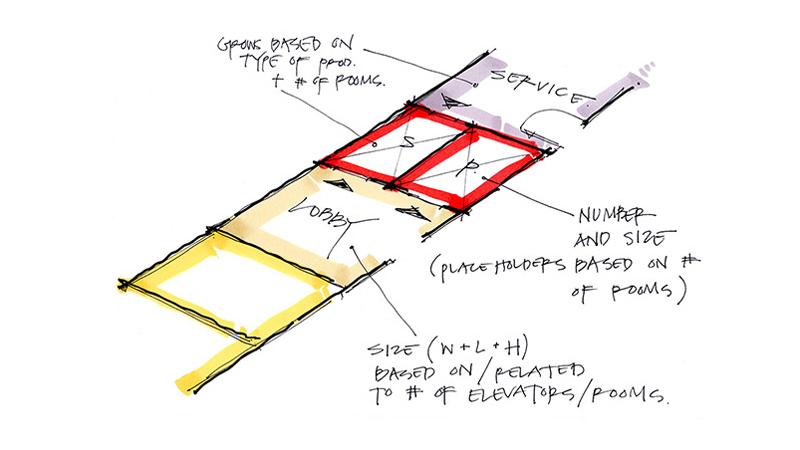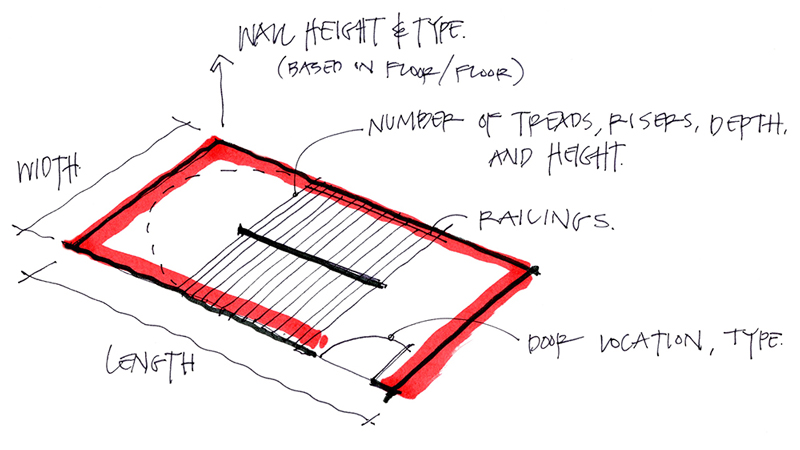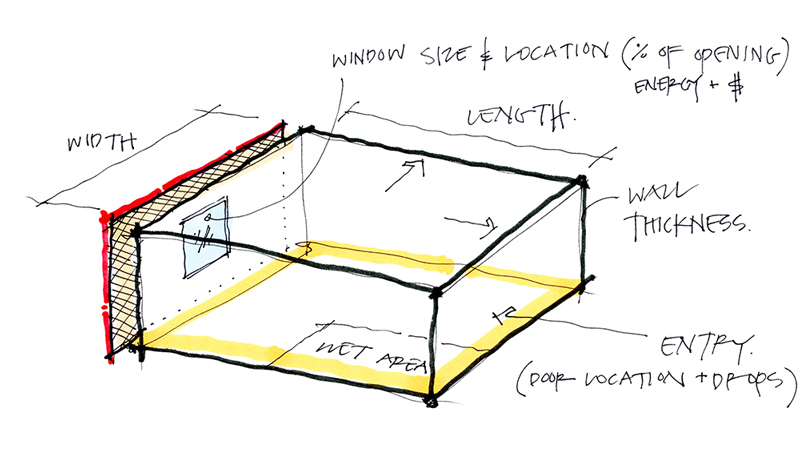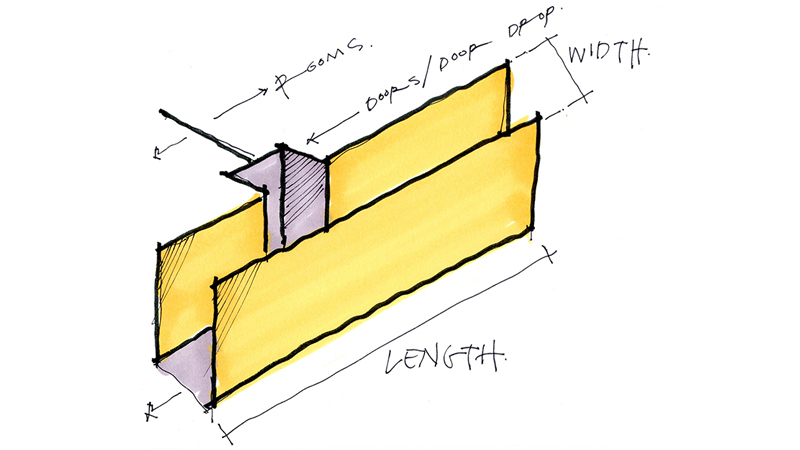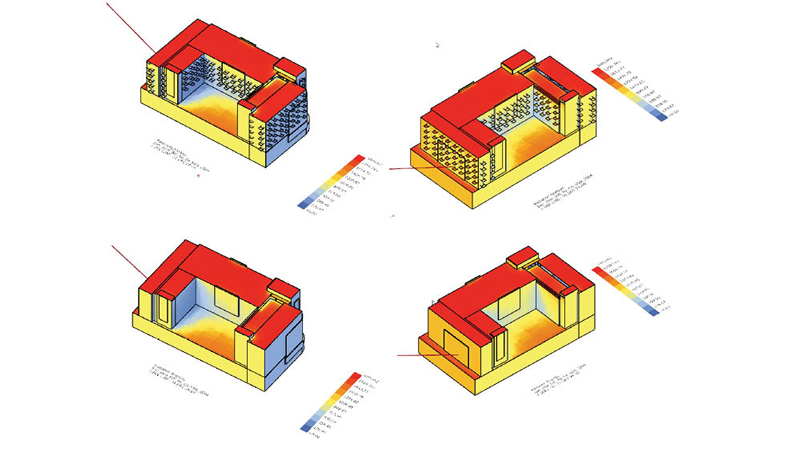LEO A DALY is named the top architecture firm for Veterans Affairs facilities by Building Design + Construction’s 2023 Giants 400 Report.
We’re celebrating National Hispanic Heritage Month
We’re celebrating National Hispanic Heritage Month

We’re celebrating National Hispanic Heritage Month! From Sept. 15 to Oct. 15, it celebrates the history and culture of U.S. Latinx and Hispanic communities. The month commemorates how these communities have influenced and contributed to American society at large. Be sure to follow us on LinkedIn to join in the dialogue.
Don Hensley, AIA, joins LEO A DALY as managing principal in Dallas
Recent Articles
BD+C Names LEO A DALY Top VA Design Firm
LEO A DALY Recognized for Leadership in Hospitality Industry
LEO A DALY Los Angeles studio earns prestigious hospitality design award and is honored for inspiring others.
Leslie Suhr promoted to Commercial Market Sector Leader
LEO A DALY celebrates the promotion of Leslie Suhr, AIA, NCARB, LEED AP BD+C to Commercial Market Sector Leader for the Omaha design studio.
Global Architecture & Design Award bestowed to LEO A DALY
University of Maryland’s Thurgood Thomas Hall earns Global Architecture & Design Award.
LEO A DALY Earns AIA Nebraska Design Award for Third Consecutive Year
AIA Nebraska recognizes the Omaha VA Ambulatory Care Center with an Architecture Citation Award
Don Hensley, AIA, joins LEO A DALY as managing principal in Dallas
Hensley brings more than 30 years of executive-level leadership experience to lead the growing Dallas architecture and interior design studio

LEO A DALY is pleased to announce that Don Hensley, AIA, LEED AP, has joined the firm as vice president and managing principal in Dallas. In this role, he leads the Dallas design studio in all matters of strategy, business development, talent management, project delivery and design excellence.
Hensley has more than 30 years of leadership experience in architecture and engineering, including executive-level positions at CannonDesign and Stantec. His portfolio of work spans market sectors and project delivery methods, including megaprojects combining a wide variety of public, private and institutional uses. He is an expert practice leader who is passionate about employee engagement, culture-building and innovation.
“I’m very excited to have Don joining LEO A DALY to fill this critical position in the Dallas studio, which is a young, vibrant, growing location. We looked long and hard for a candidate who could provide the glue for this studio, not only as a leader, but also a partner to the strong team in place. Don has a long track-record of success building multi-studio teams to partner on pursuits and projects, which will be critical to our success as we continue to grow as one firm. His experience as a practice builder will be invaluable, not just in growing our hospitality and healthcare markets in Dallas, but in seeking and delivering on new ways to serve our clients, both locally and nationwide,” said Steve Lichtenberger, AIA, president of LEO A DALY.
Hensley joins LEO A DALY at a time of significant growth for the Dallas studio. Within the last few months, the Dallas team has won several significant projects in the healthcare and hospitality markets, made a series of key hires, and moved into a state-of-the-art new studio space.
Recent project wins include two large resorts, one in Anguilla and one in Jamaica, and two major hospital projects in Oklahoma.
The Aurora Anguilla Resort & Golf Club, set to debut in November, repositions the former Resorts & Residences by Cuisinart with a new design inspired by the island’s natural splendor, traditions and personality. The project will roll out in phases, ultimately touching all of the resort’s public spaces, guest rooms and suites.
The Veterans Hospital in Tulsa (VHiT) project will convert an existing state office building adjacent to the Oklahoma State University Medical Center Campus in downtown Tulsa into a modern, 58-bed medical-surgical hospital for veterans.
The other projects remain confidential.
With the growing project load, the studio has hired for several key positions in the last few months, including three interior designers, one architect and a new director of interior design for the hospitality team.
To accommodate growth, the Dallas studio recently moved from its previous office at Mockingbird Station to One McKinney in Uptown. The new workplace was designed in-house and features a sustainable design focused on creativity, client service and flexibility. The location provides easy access to the Arts, Design and Medical Districts, where many of the firm’s vendors, clients and partners are located, and the high-rise allows for views of downtown Dallas and the surrounding parks.
The studio remains in hiring mode, including project manager positions on both the healthcare and hospitality teams.
We’re celebrating Pride Month 2021
We’re celebrating Pride Month 2021

Minneapolis studio expands healthcare team
BD+C Names LEO A DALY Top VA Design Firm
LEO A DALY is named the top architecture firm for Veterans Affairs facilities by Building Design + Construction’s 2023 Giants 400 Report.
LEO A DALY Recognized for Leadership in Hospitality Industry
LEO A DALY Los Angeles studio earns prestigious hospitality design award and is honored for inspiring others.
Leslie Suhr promoted to Commercial Market Sector Leader
LEO A DALY celebrates the promotion of Leslie Suhr, AIA, NCARB, LEED AP BD+C to Commercial Market Sector Leader for the Omaha design studio.
Global Architecture & Design Award bestowed to LEO A DALY
University of Maryland’s Thurgood Thomas Hall earns Global Architecture & Design Award.
LEO A DALY Earns AIA Nebraska Design Award for Third Consecutive Year
AIA Nebraska recognizes the Omaha VA Ambulatory Care Center with an Architecture Citation Award
Minneapolis studio expands healthcare team
Project Managers Allison Dvorak, AIA, and Michael Nelson, AIA, bring a focus on supporting medical professionals through design

LEO A DALY is pleased to announce the expansion of our healthcare design practice with the hiring of two project managers in the Minneapolis studio: Allison Dvorak and Michael Nelson.
“We’ve continued to experience tremendous growth over the last year. By leveraging this additional project management expertise, we will continue to serve our healthcare clients at the high level they’ve come to expect from our team. Allison and Michael bring a wealth of ability in carrying forward our vision for this practice,” said Market Sector Leader Daniel Abeln, AIA.
Allison Dvorak has 10 years of experience in architecture including serving as facility architect for Avera in South Dakota. Her expertise includes design and management of multi-departmental healthcare projects. She draws on this diverse background to provide her clients with a deep understanding of their process and an elevated level of service. An active member of American Institute of Architects South Dakota, Dvorak is a 2018 recipient of the AIA South Dakota Young Architects Award. She has spoken at numerous regional conferences on topics including human-centered design. Dvorak is a registered architect in South Dakota and earned a Bachelor of Environmental Science and Master of Architecture from North Dakota State University.
With 23 years of experience, Nelson brings expertise in management of healthcare projects from small renovations to major hospital expansions. Nelson is an active member of the community serving the Midtown Greenway Coalition on its executive committee and as board secretary and as former executive board president. He is a registered architect in Minnesota with a Bachelor of Environmental Design from Miami University, Oxford Ohio and a Master of Architecture from the University of Minnesota.
Dvorak and Nelson have dedicated their careers to serving clients and improving the healthcare industry. Supporting medical professionals through design is what they do best. They are a perfect fit with LEO A DALY, and our vision of enhancing the human experience through design.
LEO A. DALY Company statement against personal, institutional and systemic racism
Recent Articles
BD+C Names LEO A DALY Top VA Design Firm
LEO A DALY is named the top architecture firm for Veterans Affairs facilities by Building Design + Construction’s 2023 Giants 400 Report.
LEO A DALY Recognized for Leadership in Hospitality Industry
LEO A DALY Los Angeles studio earns prestigious hospitality design award and is honored for inspiring others.
Leslie Suhr promoted to Commercial Market Sector Leader
LEO A DALY celebrates the promotion of Leslie Suhr, AIA, NCARB, LEED AP BD+C to Commercial Market Sector Leader for the Omaha design studio.
Global Architecture & Design Award bestowed to LEO A DALY
University of Maryland’s Thurgood Thomas Hall earns Global Architecture & Design Award.
LEO A DALY Earns AIA Nebraska Design Award for Third Consecutive Year
AIA Nebraska recognizes the Omaha VA Ambulatory Care Center with an Architecture Citation Award
LEO A. DALY Company statement against personal, institutional and systemic racism

All around the United States, the communities in which we live and work are reacting in pain to injustice. Our company’s vision to transform the human experience is rooted in the humanistic belief that the actions we take and the things we say impact the world around us. LEO A. DALY Company (LEO A DALY) and its wholly owned subsidiary, Lockwood Andrews & Newnam, Inc. (LAN) join the AIA, ASCE, the National Organization of Minority Architects and other industry voices, in the chorus of humanity standing against personal, institutional and systemic racism.
We endorse the AIA’s statement:
“As Americans, we are mindful of this nation’s dark history of racial inequality. We are appalled by any actions that further threaten the universal respect and human dignity that everyone deserves. As architects, we remain committed to advancing civil rights protections, fair housing policies, and accessibility in the built world to help achieve the more perfect union we all seek. The fact is that architects and AIA, in our more than 160-year history, have not always felt compelled to share our perspectives. But the times we live in, the horrific nature of the events we witness, and the role we see for every member of our society demands that we speak out.”
We endorse ASCE’s statement:
“As leaders in our local communities, our other social or civic organizations, and in society at large, engineers must play an active role in ensuring that others within our personal and professional sphere embrace those same principles of respect and equity. We urge all members of our professional community to stand up, speak out and take action against racism and injustice wherever it occurs.”
LEO A DALY and LAN also support the universal message of restraint against violence and destruction. We look forward to listening to the voices of our colleagues, finding new ways to build understanding and enhancing pathways that achieve greater opportunities for everyone.
Leo A. Daly III, FAIA, RIBA, FRAIA
Chairman of the Board
LEO A. DALY Company
Ben Ries awarded 40 Under 40 by Consulting-Specifying Engineer
Recent Articles
BD+C Names LEO A DALY Top VA Design Firm
LEO A DALY is named the top architecture firm for Veterans Affairs facilities by Building Design + Construction’s 2023 Giants 400 Report.
LEO A DALY Recognized for Leadership in Hospitality Industry
LEO A DALY Los Angeles studio earns prestigious hospitality design award and is honored for inspiring others.
Leslie Suhr promoted to Commercial Market Sector Leader
LEO A DALY celebrates the promotion of Leslie Suhr, AIA, NCARB, LEED AP BD+C to Commercial Market Sector Leader for the Omaha design studio.
Global Architecture & Design Award bestowed to LEO A DALY
University of Maryland’s Thurgood Thomas Hall earns Global Architecture & Design Award.
LEO A DALY Earns AIA Nebraska Design Award for Third Consecutive Year
AIA Nebraska recognizes the Omaha VA Ambulatory Care Center with an Architecture Citation Award
Ben Ries awarded 40 Under 40 by Consulting-Specifying Engineer
The building-industry award recognizes superiority in academic, professional, personal and community involvement.

Electrical Project Engineer Ben Ries, PE, LC, has received the 40 Under 40 award from Consulting-Specifying Engineer. This award is given to 40 nonresidential building-industry professionals age 40 and younger who stand out for superiority in academic, professional, personal and community involvement. Ries will be recognized at a ceremony in Chicago in October 2020.
Ries’s professional work has contributed to many successful projects in Nebraska and beyond, for clients ranging from universities to corporate headquarters to military hospitals. For the past decade, Ries has also volunteered with Big Brothers Big Sisters of the Midlands. In 2016, he received the Big Brother of the Year award. He also mentors and shares his passion for engineering careers through Omaha Exploring and has received the Mentor of the Year Award from MENTOR Nebraska.
Through his design work and community involvement, Ben has contributed in many ways. He led lighting design for the pediatric hearing lab at Boys Town National Research Hospital, incorporating the universal language of Morse code. Long and short linear LED fixtures alternate down a patient hallway. They spell out the hospital’s initials – BTNRH. His custom lighting design for the Sisseton-Wahpeton Oyate tribal government headquarters won an Award of Merit from the Illuminating Engineering Society of North America. Among its features are 28 coves of light, relating to the 28 ribs of a buffalo, illuminating the sacred tribal chambers.
Ries is also a burgeoning chef, active golfer and a dedicated husband and father.
“If the technical expertise, breadth of experience and confident attitudes don’t impress you, then the dedication given to mentoring, the community and family certainly will,” said Amara Rozgus, Editor-in-Chief of Consulting-Specifying Engineer. “Now in its 13th year, the 2020 40 Under 40 winners are more creative, focused and passionate than most professionals at the early phases of their career, leading them to succeed in their respective professions.”
Learn more from Consulting-Specifying Engineer.
The future of hospitality is AI-driven
Recent Articles
The future of hospitality is AI-driven
Big data is set to disrupt the lodging industry in the form of PropTech and AI-enabled design tools. In an article for Lodging, our Dallas studio describes how AI is changing hospitality design, de-risking the hotel-development process, improving financial and operational performance and enabling a new future of data-driven design.
The following article appeared in Lodging Magazine, and can be accessed in full here. This excerpt is reproduced with permission.
AI-Driven Design Tools Could Revolutionize the Lodging Industry
Big data has taken every industry by storm, but so far the lodging industry has largely been immune. That’s set to change. Over the last few years, an army of PropTech start-ups have taken aim at the commercial real estate industry, positioning themselves to disrupt how developers buy, sell, and manage property. Commercial real estate is the tip of the spear right now, but the lodging industry’s turn is right around the corner.
For hospitality architects, big data has the potential to help plan more efficient and profitable hotels, streamline the design process, and improve the guest experience. AI-powered tools are de-risking the hotel development process, improving financial and operational performance and enabling a new future of data-driven design.
Read more:
 Ryan Martin
Ryan Martin
Director of Design – Hospitality
The advantages of AI-driven design are profound. Rather than spending a little time being creative and a lot of time crunching numbers, generative design allows designers to spend a little time up-front dialing in variables, and more time crafting guest experiences. More importantly, the generative approach creates data-rich architecture in a way passive design doesn’t. Because the digital models that emerge are still attached to the data sets that originate them, designers can continue tweaking parameters and see how it affects performance throughout the design process.
Mark Pratt joins LEO A DALY as global hospitality practice leader
Recent Articles
BD+C Names LEO A DALY Top VA Design Firm
LEO A DALY is named the top architecture firm for Veterans Affairs facilities by Building Design + Construction’s 2023 Giants 400 Report.
LEO A DALY Recognized for Leadership in Hospitality Industry
LEO A DALY Los Angeles studio earns prestigious hospitality design award and is honored for inspiring others.
Leslie Suhr promoted to Commercial Market Sector Leader
LEO A DALY celebrates the promotion of Leslie Suhr, AIA, NCARB, LEED AP BD+C to Commercial Market Sector Leader for the Omaha design studio.
Global Architecture & Design Award bestowed to LEO A DALY
University of Maryland’s Thurgood Thomas Hall earns Global Architecture & Design Award.
LEO A DALY Earns AIA Nebraska Design Award for Third Consecutive Year
AIA Nebraska recognizes the Omaha VA Ambulatory Care Center with an Architecture Citation Award
Mark Pratt joins LEO A DALY as global hospitality practice leader
Pratt succeeds Pat Miller, who is segueing into a senior hospitality advisory role after 21 years

LEO A DALY is pleased to announce the hire of hospitality-industry veteran Mark Pratt, AIA, as global hospitality practice leader. In this role, Pratt leads strategy and business development for LEO A DALY’s internationally renowned hospitality design group.
Pratt has devoted a 34-year career to working with developers, hoteliers and municipalities to envision and realize hospitality projects that meet and exceed their business and placemaking goals. His expertise is comprehensive, covering all phases of planning, design and construction across the spectrum of hospitality, including luxury, full-service, boutique, resort and convention center hotels. His expertise in brand selection and approval processes, site selection and design and his ability to source equity for the capital stack, make him an outstanding asset to the LEO A DALY’s hospitality clients.
“LEO A DALY is dedicated to helping our hospitality clients create unforgettable guest experiences through exceptional design. We are thrilled to have Mark lead our global hospitality practice, leveraging a wealth of design talent, experience and creativity to shape the future of hospitality,” said Steven A. Lichtenberger, AIA, president of LEO A DALY.
Pratt succeeds Pat Miller, a beloved and influential figure in the world of hospitality design, who over the last 21 years led LEO A DALY’s hospitality practice to become one of the top ranked in the industry. Miller will continue to serve the firm as a senior hospitality advisor, consulting on strategy, brand and talent development and client service.
“Pat Miller put LEO A DALY on the hospitality-design map. Her reputation for outstanding client leadership, talent development and high design will forever be embedded in our firm’s DNA. These are also things Mark believes deeply in, which, along with his own reputation for innovation and thought leadership, make him a great fit to lead LEO A DALY’s hospitality practice,” said Ignacio Reyes, AIA, director of business development.
Healthcare flooring to wow and calm
Recent Articles
Healthcare flooring to wow and calm
In Medical Construction & Design, interior designers Jen Ankerson and Heather Robbins discuss how smart flooring choices can strengthen branding for healthcare providers
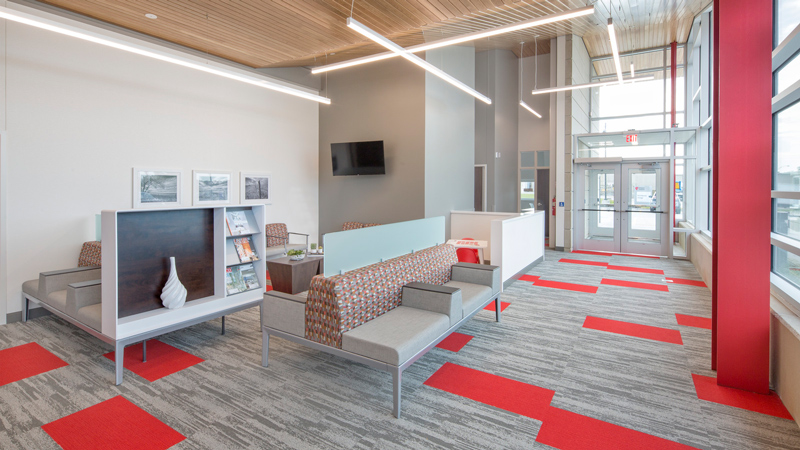
Excerpted from the article:
Consumerism is changing the business of healthcare, and brand loyalty is the holy grail. As patients take more control over their health spending, providers can influence buying decisions by offering a patient experience that is pleasant, convenient, and seamless across digital platforms and physical locations.
As retailers and hoteliers know, design is central to the customer experience. The way a space looks and feels creates an emotional response that sticks in your memory, creates positive associations, and ultimately influences the strength of a brand.
Flooring decisions, while always important in healthcare for practical reasons such as infection control, are now given added weight. Beyond initial cost, durability, maintenance, sustainability, noise, and wayfinding, flooring is now viewed as an integral part of a branded patient experience.
Inspired by trends in hospitality, residential, and retail design, the new wave of healthcare flooring is simple, naturalistic, comforting and even fun. Rather than seek to distract, today’s best flooring solutions fit together with strategic architectural and furnishing decisions to create memorable moments for patients and inspire brand loyalty.
Creating brand moments
In their 2017 book The Power of Moments, branding gurus Chip and Dan Heath share a powerful bit of insight about how customers experience brands:
“When we assess our experiences,” they write, “we don’t average our minute-by-minute sensations. Rather, we tend to remember flagship moments: the peaks, the pits and the transitions. This is a critical lesson for anyone in the service business, from restaurants to medical clinics.”

Flooring can assist in creating flagship moments in two main ways: it can pop, or it can go away to allow other elements of the design to take center stage.
Nebraska Medicine’s new primary-care clinic prototype is a great example of flooring creating a wow moment. In the lobby and staff spaces, bright red carpet tiles pop from the neutral gray background, giving the entry experience a sense of energy that is instantly memorable.
Throughout the clinic, red appears in different forms – in carpeting, upholstery, wall art, painted beams, and translucent dividers – creating total look and feel that embodies Nebraska Medicine’s motto of “Serious Medicine, Extraordinary Care.” By repeating this prototype scheme in four new clinics throughout the Omaha metro area, patients feel connected to a seamless care experience that capitalizes on experiential design.
The carpeting at Creighton University Medical Center’s new Bergan Mercy ambulatory clinic plays the opposite role of Nebraska Medicine’s wild red – blending into the background to allow pops of “Creighton blue” to speak. An abstract carpet pattern of taupe and gray complements wood-look ceiling tiles and stair treads, but mostly avoids attention. Meanwhile, blue acrylic clouds, furniture, signage and LED lighting contribute to an overall experience that reinforces patients’ associations to the university.
Whether blending into the background or grabbing attention, thoughtful flooring decisions are an important part of creating a distinctive patient experience, fitting together with other design elements to create a cohesive picture of the brand.
Making it like home
Patient comfort is a primary goal of every healthcare project, reducing the stress inherent in healthcare situations. As healthcare designers, we aim to create environments that are homelike, and often find ourselves inspired by trends in residential design.
Today’s home décor trends favor neutral grays, natural materials, and pops of color that can be easily changed as trends come and go without requiring a major overhaul. Browns are out, and lighter tones such as whitewashed wood-look LVT are in.
The beauty of neutral grays is that they allow the warmth of wood, the textures of stone, and the richness of saturated colors to shine, resulting in a layered, sophisticated aesthetic.
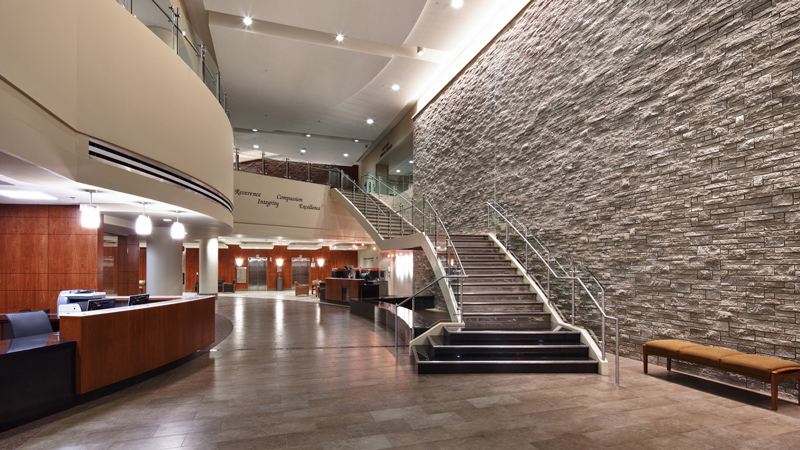
This layering of textures and materials is shown dramatically in KentuckyOne Health’s St. Joseph London hospital in London, Kentucky. A neutral porcelain tile floor in the hospital’s main entry sequence provides an elegant but understated foreground for a massive, double-height stone wall, which brings in the textures of nature. Dark wood in paneling and furniture is used sparingly to add warmth to the space, and create a memorable and comforting patient experience.
In patient rooms, where both comfort and infection control are high priorities, designers are always looking for products that meet high aesthetic standards while still offering a seamless, non-porous surface where germs can’t hide. In recent years, manufacturers have gotten better at achieving a convincing wood look in a sheet vinyl product.
The patient rooms at Irwin Army Community Hospital do a great job of balancing infection control and patient experience. Inspired by the natural beauty of the Kansas prairie, the pine-look sheet flooring brings in bright, blonde notes that makes the space fresh and clean. Wall treatments bring in tree-branch shapes, and large windows take advantage of strategic building siting to fill the room with natural light and allow views to untouched nature.
By employing the timeliness of current residential trends and the timelessness of nature, great flooring decisions become an integral part of a calm, pleasant patient experience.
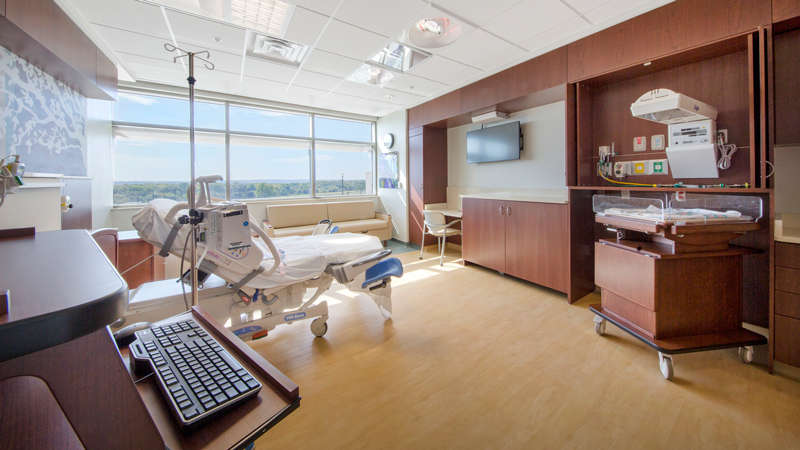
Staying practical
Even as consumerism pushes healthcare flooring decisions into the realm of boutique design, it’s important to note that practicality still reigns supreme in healthcare.
Healthcare flooring takes a lot of abuse, its cleaning regimens are more intense, and its applications are generally so extensive that it’s important to go with manufacturers you can trust. No matter how dazzling the flooring is on day one, it’s important to think long-term about whether the manufacturer will still be able to deliver the same products down the road.
It’s also worth noting that a lot of interior design elements “ugly out” before they wear out. A color that’s fashionable today might be hopelessly dated next year. When choosing trendy colors for healthcare spaces, it’s best to use them in applications where they can be changed easily and cheaply. If you have to choose between a trendy floor offering a pop of color, or an accent wall that can be easily repainted, go with the accent wall. It’s much harder to replace flooring. When in doubt, it’s best to pick timeless, neutral flooring that will go with anything.
As healthcare systems become more sophisticated about how they brand themselves, there will continue to be new opportunities to create memorable moments for patients. Flooring is a big part of that, whether it’s function is to pop or fade into the background. By employing the tools of experiential design, interior designers can turn every touchpoint into a chance to engage with the brand and drive patient loyalty.
Download the article:


